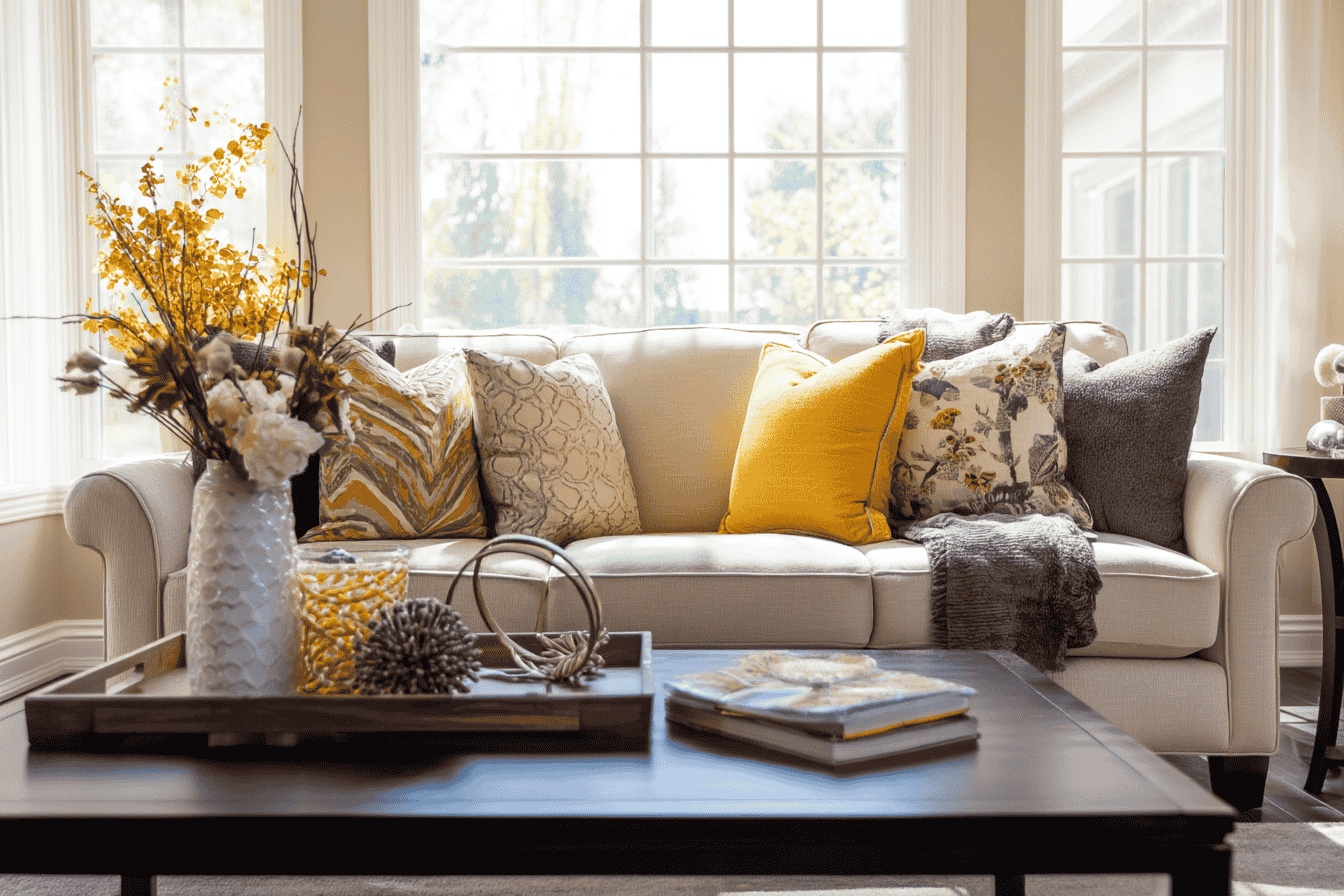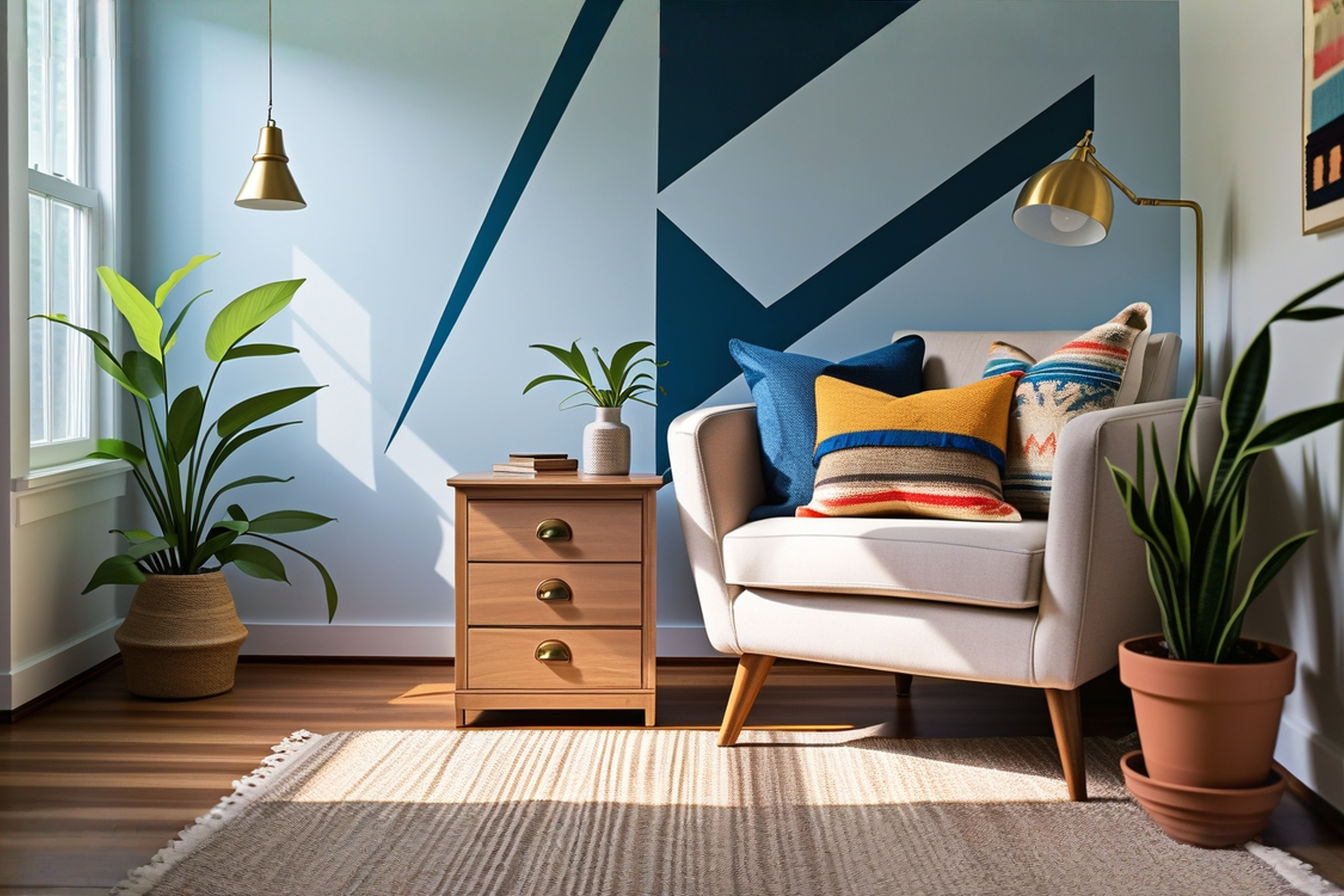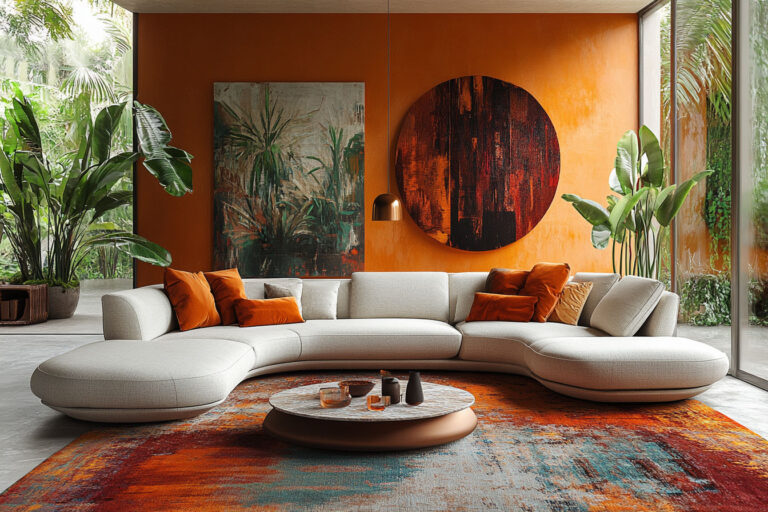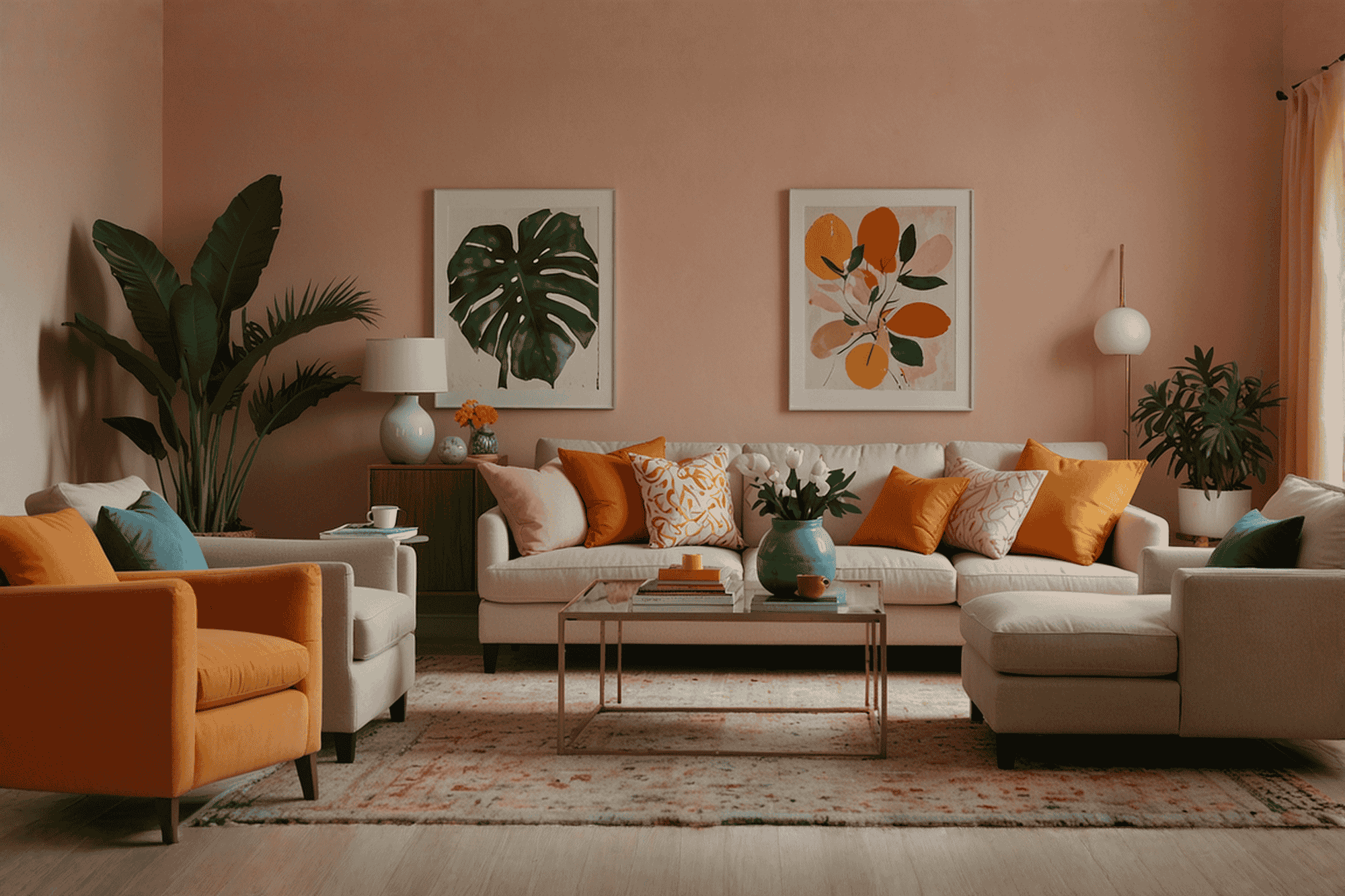This post may contain affiliate links. If you make a purchase through these links, we may earn a commission at no additional cost to you.
That vast, empty wall space can feel like both an opportunity and a challenge. Perhaps you’ve moved into a new home with soaring ceilings, or maybe you’re finally tackling that bare living room wall that’s been staring back at you for months. When you start shopping for artwork sized to fill these substantial spaces, sticker shock quickly follows. Large-scale wall art often comes with price tags that can send even the most dedicated decorator running for cover.
Fortunately, creating visual impact doesn’t require emptying your savings account. This guide explores seven innovative approaches to large wall art that combine creativity with affordability. These ideas range from simple DIY projects to clever sourcing strategies, all designed to help you transform blank walls into captivating focal points without the premium price tag.
Whether you’re an apartment dweller working with temporary constraints, a homeowner seeking to maximize your decorating budget, or simply someone who enjoys the satisfaction of creating something beautiful with your own hands, these budget-friendly options will inspire you to think beyond traditional canvas art and embrace your creative potential.
Why Large Wall Art Makes a Difference
The relationship between a room’s dimensions and the scale of its decorative elements fundamentally shapes how we experience a space. Large wall art creates visual anchors that help define and balance a room’s proportions. When properly sized, statement pieces draw the eye, establish focal points, and prevent the scattered, unfinished feeling that comes from decorating with pieces that are too small for their surroundings.
The psychology behind statement art reveals why many spaces feel incomplete without it. Our brains naturally seek visual hierarchy and organization. A substantial art piece creates immediate order by establishing dominance in the visual field. This effect goes beyond mere aesthetics – properly scaled wall art can make a room feel more intentional, finished, and cohesive.
Many decorators fall into the common trap of “postage stamp art” – using pieces that are disproportionately small for their wall space. This creates visual disconnection and can actually make a room feel less personal and more institutional. Another mistake is allowing budget constraints to result in barren walls, which diminishes the comfort and character of living spaces. The solutions in this guide address both issues by providing approaches that maximize visual impact while minimizing financial outlay.
1. DIY Oversized Canvas Art
Creating your own large-scale canvas art represents one of the most direct ways to achieve stunning wall decor at a fraction of gallery prices. The beauty of this approach lies in its customization potential – you control every aspect from color palette to composition.
Materials Needed:
For a basic 4′ x 3′ canvas project, expect to need:
- Pre-stretched canvas or canvas drop cloth ($15-30)
- Wooden stretcher bars if using drop cloth ($10-20)
- Acrylic paints in your chosen colors ($15-25)
- Various brushes, spatulas, or application tools ($10-15)
- Primer if using unstretched canvas ($8)
Techniques That Deliver:
Abstract color blocking provides an approachable entry point for beginners. This technique involves creating geometric or organic shapes in complementary or contrasting colors. The simplicity of execution belies the sophisticated result, especially when colors are thoughtfully chosen to complement your existing decor.
Textured applications add dimension through mixed media approaches. Consider incorporating modeling paste, tissue paper, or even sand into your paint for tactile interest. These techniques create visual complexity that draws viewers closer to examine the details.
Poured and dripped techniques produce fluid, organic patterns with minimal artistic skill required. By mixing acrylic paint with pouring medium, you can create marbled effects, cells, and flowing color interactions that appear much more complex than their execution demands.
The total cost typically ranges from $40-80 depending on size and materials chosen – a mere fraction of the $300-1000 price tag for comparable purchased pieces. Beyond the financial savings, the personal connection to artwork you’ve created yourself adds immeasurable value to your space.
2. Fabric Wall Hangings and Textiles
Textiles offer exceptional value for large-scale wall decor, providing color, pattern, and texture in one versatile medium. Fabric installations bring immediate warmth to spaces that might otherwise feel stark or impersonal.
Choosing the Right Fabrics:
Vintage scarves, particularly those with bold graphic patterns or hand-painted designs, provide instant artwork with minimal modification needed. These can often be found at thrift stores or estate sales for $5-15.
Imported textiles such as Indian block-print bedspreads, Indonesian batiks, or African mud cloth deliver cultural richness and artisanal quality at reasonable prices, typically ranging from $20-60 for sizeable pieces.
Remnant upholstery fabrics offer substantial weight and impressive patterns at significant discounts. Many fabric stores sell these end-of-bolt pieces for 50-70% less than regular inventory, making high-end designer fabrics accessible for wall art projects.
Mounting Solutions:
For lighter fabrics, tension rod hanging creates a clean, floating appearance. This approach costs $10-15 and requires no permanent wall modification, making it ideal for renters.
Wood dowel or bamboo pole mounts provide a more substantial frame for medium-weight textiles. These can be assembled for $5-10 and attached with decorative cord or leather straps for additional visual interest.
Stretching fabric over canvas stretcher bars or lightweight wood frames creates a more traditional presentation. This method, costing $15-25 for materials, works exceptionally well for fabrics with continuous patterns.
The beauty of textile wall art lies in its immediate impact combined with minimal technical requirements. Even those with no artistic experience can select and display a compelling fabric piece. The softness these installations bring to a space counters the hardness of walls and furniture, creating more acoustic and visual comfort in your environment.
3. Gallery Walls with Budget Frames
Gallery walls transform collections of smaller, affordable pieces into impactful arrangements that command attention. This approach allows you to cover substantial wall areas without the cost of single oversized pieces.
Sourcing Frames Creatively:
Thrift stores, garage sales, and flea markets yield abundant frame options typically priced between $1-10 each. Look beyond condition to potential – ornate frames with dated finishes can be transformed with simple spray paint.
Big-box retailers like IKEA, Target, and Walmart offer basic frame sets that, when arranged thoughtfully, appear much more substantial than their price suggests. Watch for seasonal clearance events where frames are often discounted 50-70%.
Repurposed architectural elements such as window frames, cabinet doors, or decorative wood molding create distinctive framing options that stand apart from mass-produced alternatives. These found objects add character while keeping costs minimal.
Creating Cohesion:
Unify disparate frames through consistent finishes. A collection of mismatched frames becomes a coordinated set when painted in a single color or compatible metallic tones.
Consider content themes that tie your collection together – botanical prints, black and white photography, abstract shapes, or vintage travel images provide visual continuity across multiple pieces.
The space between frames contributes significantly to the overall effect. Maintain consistent spacing (typically 2-3 inches) for a more formal, gallery-like appearance, or vary spacing slightly for a more relaxed, evolved look.
Gallery walls particularly shine in spaces where personality matters. Unlike single large pieces that make one statement, these collections tell more complex visual stories through multiple images, creating conversation starters and reflecting your unique aesthetic perspective.
4. Large-Scale Photography Prints
Photography offers exceptional value for large-scale wall decor, particularly when you leverage digital files and alternative printing methods. The key lies in thinking beyond traditional photo printing services.
Finding High-Quality Images:
Your own smartphone photos can provide surprisingly suitable material when properly edited. Landscape panoramas, architectural details, and macro nature photography often translate beautifully to large formats.
Public domain archives like the Library of Congress, NASA image gallery, and museum digital collections offer thousands of high-resolution historical images free for personal use.
Emerging photographers on platforms like Etsy or Society6 often sell digital download options of their work for $5-20, permitting you to print at any size without the markup of physical products.
Cost-Effective Printing Options:
Engineering prints (also called blueprint or architectural prints) represent the most affordable large-format option. These black and white or color prints cost $5-25 for sizes up to 36″ x 48″ at office supply stores or print shops.
Rasterbator and similar online tools divide images across multiple standard-sized sheets that you print and assemble. This approach costs merely the price of paper and ink while achieving dimensions of 6′ or larger.
Canvas print services frequently offer promotional discounts of 50-70% off, bringing 30″ x 40″ prints down to the $30-60 range when you time your purchase strategically.
Display Approaches:
Magnetic poster hangers provide clean, minimalist framing for $15-25, creating a floating effect that emphasizes the image rather than its frame.
DIY floating frames using clear acrylic sheets and standoff hardware create a modern gallery presentation for $25-40, significantly less than comparable retail options.
Japanese-inspired wood hanging frames using simple dowels and clips offer an elegant solution for $10-15 that works particularly well for documentary or artistic photography.
The democratization of photography and printing technology has transformed what’s possible in affordable wall decor. Images that would have required considerable investment a decade ago can now adorn your walls for less than the cost of dining out.
5. Repurposed Items as Wall Art
Everyday objects reimagined as art deliver both visual impact and sustainability benefits. This approach transforms the overlooked into the extraordinary, often at minimal cost.
Finding Objects with Artistic Potential:
Vintage tools, particularly those with interesting patinas and shapes, create compelling wall installations. Farm implements, kitchen tools, and workshop instruments offer industrial charm for typically $5-15 per piece at flea markets.
Textile tools like looms, spindles, and drying racks provide organic shapes and textures that complement both modern and traditional interiors. These functional objects bring craftsmanship and history to your walls.
Natural elements including driftwood, preserved botanicals, and mineral specimens offer organic beauty and tactile interest. Beach combing, forest walks, and rock hunting yield free materials that can be artfully arranged.
Creating Cohesive Displays:
Group similar objects in grid patterns or organic clusters to transform individual items into unified compositions. The repetition of forms creates rhythm and intentionality.
Consider shadow box mounting for smaller objects, creating depth and highlighting each item against a contrasting background. Simple DIY shadow boxes cost $15-30 to construct compared to $50-100 retail.
Unexpected juxtapositions – such as arranging utilitarian items in formal, museum-like presentations – create visual tension that elevates ordinary objects to artistic status.
This approach particularly resonates with environmentally conscious decorators and those who value objects with history and character. Beyond their visual appeal, these installations often become conversation pieces that connect your space to broader narratives about craftsmanship, history, and material culture.
6. Wall Murals and Paint Techniques
Paint remains the most economical medium for transforming large wall spaces. Contemporary approaches go far beyond solid colors to create artistic effects at minimal cost.
Accessible Techniques for Non-Artists:
Color blocking using painter’s tape creates geometric patterns with clean, professional edges. This approach requires only paint ($30-50) and tape ($10), yet produces results comparable to high-end wallpaper.
Ombré and gradient effects achieve sophisticated depth through simple blending techniques. By gradually transitioning between two or three colors, you create dynamic motion across the wall space.
Stencil applications have evolved far beyond outdated borders and country motifs. Modern geometric, botanical, and abstract stencils transform walls with pattern and texture for $15-30 plus paint costs.
Execution Tips:
Test techniques on large poster boards before committing to your wall. This allows you to perfect your approach and confirm color relationships at a larger scale than paint chips permit.
Consider partial applications rather than full wall coverage. A painted “frame” that extends 2-3 feet from the ceiling or a pattern that covers only the wall’s central portion can create focal points without overwhelming the space.
Embrace imperfection in hand-painted techniques. The slight variations and human touches differentiate your walls from machine-printed alternatives and contribute to their artistic character.
Paint techniques offer particular advantages for renters and frequent redecorators. Unlike more permanent installations, these approaches can be modified or painted over as tastes and needs change, providing maximum flexibility with minimal investment.
7. Woven and Macramé Wall Art
Fiber arts have experienced a remarkable renaissance, combining traditional techniques with contemporary aesthetics. These textural pieces add dimensional interest that flat artwork cannot achieve.
Beginner-Friendly Approaches:
Basic macramé wall hangings require only knowledge of a few fundamental knots. Starting with simple patterns using cotton rope ($15-25) delivers impressive results even for first-time creators.
Woven wall hangings using simple frame looms require minimal equipment investment ($20-30) while offering endless creative possibilities through yarn selection and technique variation.
Branch and dowel suspensions using natural materials create organic frameworks for fiber installations. These approaches emphasize negative space and natural elements for a more subtle effect.
Scaling Up Affordably:
Chunky yarns and ropes create substantial pieces with less time investment. Materials like jersey yarn made from recycled t-shirts provide volume and texture at lower cost ($10-20) than specialty fibers.
Incorporate found materials including driftwood, copper pipe, or bamboo as structural elements. These additions expand the visual footprint of your piece while adding contrasting textures.
Consider dimensional variations where elements extend outward from the wall at different depths. This approach increases visual impact without requiring additional width or height.
Fiber arts particularly excel in spaces that need acoustic improvement and softness. Beyond their visual appeal, these textural installations absorb sound and counter the hard surfaces typical in contemporary interiors, creating more comfortable environments.
Conclusion
The blank wall represents not a decorating challenge but an opportunity for creative expression. Each approach outlined here offers distinct advantages beyond mere affordability. DIY canvas art provides complete customization; textile hangings bring immediate warmth and color; gallery walls tell complex visual stories; photography delivers dramatic scale at minimal cost; repurposed objects connect spaces to history and craft; paint techniques offer flexibility and bold impact; fiber arts add dimension and texture.
The most successful large-scale wall treatments often combine elements from multiple approaches. A painted accent wall might serve as backdrop for fiber art, or a gallery arrangement might incorporate both photographs and repurposed objects. This layering creates visual richness that exceeds what any single technique could achieve.
Remember that effective wall decor reflects not just current trends but your authentic interests and experiences. The most compelling spaces tell stories about their inhabitants through thoughtfully selected visual elements. When your wall decor sparks conversation, evokes memories, or simply brings you joy when you enter the room, it has succeeded regardless of its price tag.
Start with a single wall or even a portion of one wall as you experiment with these techniques. Document your process and celebrate both successful outcomes and instructive failures. Each project builds skills and confidence for the next. The journey toward personalized, budget-friendly wall decor is as rewarding as the finished result – perhaps even more so when you consider the satisfaction of creating something uniquely yours without breaking the bank.






